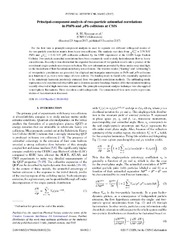Principal-component analysis of two-particle azimuthal correlations in PbPb and pPb collisions at CMS
| dc.creator | Sirunyan, A. M. | |
| dc.creator | Adžić, Petar | |
| dc.creator | Ćirković, Predrag | |
| dc.creator | Devetak, Damir | |
| dc.creator | Đorđević, Miloš | |
| dc.creator | Milošević, Jovan | |
| dc.creator | Reković, Vladimir | |
| dc.creator | Milenović, Predrag | |
| dc.date.accessioned | 2018-03-01T18:01:38Z | |
| dc.date.available | 2018-03-01T18:01:38Z | |
| dc.date.issued | 2017 | |
| dc.identifier.issn | 2469-9985 | |
| dc.identifier.issn | 2469-9993 | |
| dc.identifier.uri | https://vinar.vin.bg.ac.rs/handle/123456789/1851 | |
| dc.description.abstract | For the first time a principle-component analysis is used to separate out different orthogonal modes of the two-particle correlation matrix from heavy ion collisions. The analysis uses data from root s(NN) = 2.76 TeV PbPb and root s(NN) = 5.02 TeV pPb collisions collected by the CMS experiment at the CERN Large Hadron Collider. Two-particle azimuthal correlations have been extensively used to study hydrodynamic flow in heavy ion collisions. Recently it was shown that the expected factorization of two-particle results into a product of the constituent single-particle anisotropies is broken. The new information provided by these modes may shed light on the breakdown of flow factorization in heavy ion collisions. The first two modes (leading and subleading) of two-particle correlations are presented for elliptical and triangular anisotropies in PbPb and pPb collisions as a function of p(T) over a wide range of event activity. The leading mode is found to be essentially equivalent to the anisotropy harmonic previously extracted from two-particle correlation methods. The subleading mode represents a new experimental observable and is shown to account for a large fraction of the factorization breaking recently observed at high transverse momentum. The principle-component analysis technique was also applied to multiplicity fluctuations. These also show a subleading mode. The connection of these new results to previous studies of factorization is discussed. | en |
| dc.relation | BMWFW (Austria), FWF (Austria), FNRS (Belgium), FWO (Belgium), CNPq (Brazil), CAPES (Brazil), FAPERJ (Brazil), FAPESP (Brazil), MES (Bulgaria), CERN, CAS (China), MoST (China), NSFC (China), COLCIENCIAS (Colombia), MSES (Croatia), CSF (Croatia), RPF (Cyprus), SENESCYT (Ecuador), MoER (Estonia), ERC IUT (Estonia), ERDF (Estonia), Academy of Finland, MEC (Finland), HIP (Finland), CEA (France), CNRS/IN2P3 (France), BMBF, Germany, DFG (Germany), HGF (Germany), GSRT (Greece), OTKA (Hungary), NIH (Hungary), DAE (India), DST (India), IPM (Iran), SFI (Ireland), INFN (Italy), MSIP (Republic of Korea), NRF (Republic of Korea), LAS (Lithuania), MOE (Malaysia), UM (Malaysia), BUAP (Mexico), CINVES-TAV (Mexico), CONACYT (Mexico), LNS (Mexico), SEP (Mexico), UASLP-FAI (Mexico), MBIE (New Zealand), PAEC (Pakistan), MSHE (Poland), NSC (Poland), FCT (Portugal), JINR (Dubna), MON (Russia), RosAtom (Russia), RAS (Russia), RFBR (Russia), RAEP (Russia), MESTD (Serbia), SEIDI (Spain), CPAN (Spain), PCTI (Spain), FEDER (Spain), Swiss Funding Agencies (Switzerland), MST (Taipei), ThEPCenter (Thailand), IPST (Thailand), STAR (Thailand), NSTDA (Thailand), TUBITAK (Turkey), TAEK (Turkey), NASU (Ukraine), SFFR (Ukraine), STFC (United Kingdom), DOE (USA), NSF (USA), Marie Curie program (European Union), European Research Council and Horizon (European Union) [675440], Leventis Foundation, A.P. Sloan Foundation, Alexander von Humboldt Foundation, Belgian Federal Science Policy Office, Fonds pour la Formation a la Recherche dans lIndustrie et dans lAgriculture (FRIA-Belgium), Agentschap voor Innovatie door Wetenschap en Technologie (IWT-Belgium), Ministry of Education, Youth and Sports (MEYS) of the Czech Republic, Council of Science and Industrial Research, India, HOMING PLUS program of the Foundation for Polish Science, European Union, Regional Development Fund, Ministry of Science and Higher Education, National Science Center (Poland) [Harmonia 2014/14/M/ST2/00428, Opus 2014/13/B/ST2/02543, 2014/15/B/ST2/03998, 2015/19/B/ST2/02861, Sonatabis 2012/07/E/ST2/01406], National Priorities Research Program by Qatar National Research Fund, Programa Clarin-COFUND del Principado de Asturias, Thalis program, EU-ESF, Greek NSRF, Rachadapisek Sompot Fund for Postdoctoral Fellowship, Chulalongkorn University (Thailand), Chulalongkorn Academic into Its 2nd Century Project Advancement Project (Thailand), Welch Foundation [C-1845], Aristeia program | |
| dc.rights | openAccess | en |
| dc.rights.uri | https://creativecommons.org/licenses/by/4.0/ | |
| dc.source | Physical Review C | en |
| dc.title | Principal-component analysis of two-particle azimuthal correlations in PbPb and pPb collisions at CMS | en |
| dc.type | article | en |
| dc.rights.license | BY | |
| dcterms.abstract | Рековиц, В.; Ћирковић Предраг; Aдзиц, П.; Деветак Дамир; Сирунyан, A. М.; Ђорђевић Милош; Милошевић Јован; Миленовић Предраг; | |
| dc.citation.volume | 96 | |
| dc.citation.issue | 6 | |
| dc.identifier.wos | 000417077300003 | |
| dc.identifier.doi | 10.1103/PhysRevC.96.064902 | |
| dc.citation.other | Article Number: 064902 | |
| dc.citation.rank | M21 | |
| dc.contributor.count | CMS Collaboration (ukupan broj autora: 2220) | |
| dc.type.version | publishedVersion | |
| dc.identifier.scopus | 2-s2.0-85038612821 | |
| dc.identifier.fulltext | https://vinar.vin.bg.ac.rs//bitstream/id/12169/1847.pdf |

